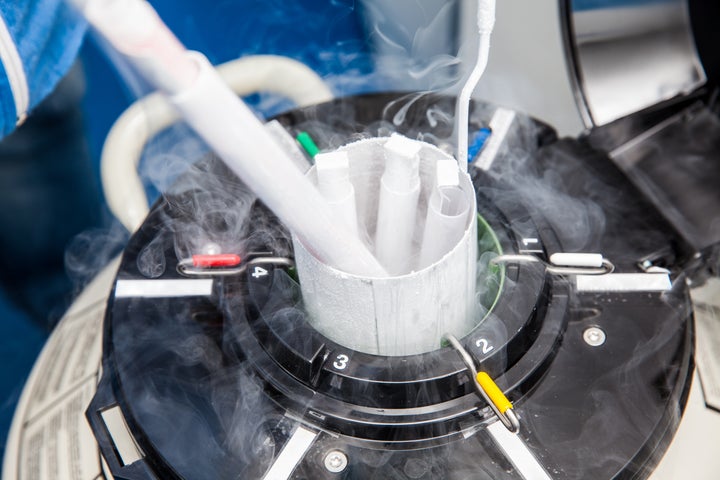Amber Ash was 33 when she underwent her first in vitro fertilization treatment in 2014, using sperm that her husband, Elliot, had saved before undergoing treatment for Ewing sarcoma, a rare cancer.
The IVF cycle yielded 10 embryos, and doctors used eight of them for three transfer procedures before the couple finally conceived their son in 2014.
Amber and Elliot thought of the two remaining embryos as “frozen children” and believed each embryo represented a chance to give their son a genetic sibling.
“For us, our belief system is that these weren’t just frozen cells,” Amber said. “These really were our frozen children.”
The Ash family’s hopes for completing their family were dashed earlier this month, when a storage tank at the University Hospitals’ Fertility Center in Cleveland malfunctioned and warmed thousands of embryos and other genetic material, rendering them unusable. San Francisco’s Pacific Fertility Center experienced a similar problem the same week.
Since receiving the news that their two remaining frozen embryos were lost, the Ashes have been exploring their dwindling options for giving their son a little brother or sister.
This is possible: Elliot does have some remaining sperm in storage and though Amber’s age of 37 means her fertile window may soon begin to close, there is still time to seek more treatments.
But what happened to their embryos has led the Ashes to commit to ensuring that storage malfunctions like the one that took place at the UH fertility clinic will never happen again. They’ve become the face of one of a handful of class action lawsuits filed against the clinic for the loss.
“Our goal from day one has been to really impact policy and practice regarding the storage and safety regarding the monitoring [of] embryos, as well as eggs and sperm,” Amber said about the lawsuit.
“We just don’t want this to happen to any other family ever again,” Elliot added.
Because it’s so rare, there is no data about how often embryos are destroyed through carelessness, negligence or unforeseen events at fertility labs. But it can happen — and not just because of equipment malfunctions. Clinics have lost track of embryos in their own storage equipment, embryos have been placed into the wrong patients and power outages have rendered storage tanks useless.
Currently, one law firm that has filed class action suits against both UH Fertility Center and Pacific Fertility Center because of their recent storage tank malfunctions is also representing a couple in Orange County, California, that claims they asked their clinic to transfer their two remaining embryos to a new clinic, only for the second lab to discover there was nothing inside the tube.
While it isn’t yet clear whether mechanical failure or human error is to blame for either case, initial media reports about UH Fertility Center indicate that multiple alarms were supposed to go off once temperatures began climbing ― but that the laboratory was not staffed the night before the discovery.
“We’ve had no legislation in the area because politicians don’t want to get into telling people who can have a baby, and they don’t want to get into further arguments about what an embryo is.”
- Arthur Caplan, bioethicist at New York University
Since the first baby conceived via in vitro fertilization was born in 1978, almost 1 million people in the U.S. have been born thanks to IVF and other assisted reproductive techniques. That means fertility clinics in the U.S. are a big and growing business, but they are not subject to the same federal or even state regulation with which many other types of medical facilities must comply.
The federal government requires fertility clinics to report their success rates to the U.S. Centers for Disease Control and Prevention, and the CDC in turn can visit clinics or perform audits to validate that reported information. It also publishes the names of clinics that don’t report their data.
States can pass laws that require fertility clinics to be accredited (California does; Ohio does not) or regulate some aspects of fertility treatment services.
But most states are loath to do so, said Arthur Caplan, a bioethics expert at New York University and author of the book Am I My Brother’s Keeper? The Ethical Frontiers Of Biomedicine.
“We’ve had no legislation in the area because politicians don’t want to get into telling people who can have a baby, and they don’t want to get into further arguments about what an embryo is,” Caplan said. “They’ve had enough of this in abortion, so they’ve stayed away.”
Indeed, policies that govern reproductive health services can have more to do with the political climate around the service than safeguarding the health and well-being of patients. Abortion, Caplan pointed out, is heavily regulated, and policies range from the number of times patients have to undergo ultrasounds and hear heartbeats to laws about how clinics should be located within a minimum distance from a hospital, with minimum standards for the size of exam rooms and corridors, with no evidence for its benefits for patients.
In contrast, there are no regulations for staff training or fail-safe equipment at fertility clinics, said Caplan.
Trade groups like the Society for Assisted Reproductive Technology, an arm of the nonprofit American Society for Reproductive Medicine, have stepped into the void left by a lack of regulation. SART offers clinics membership, provided that they accredit their laboratory every two years by either the Joint Commission, the College of American Pathologists, or a state agency (currently, only New York has this agency in place).
In return, SART aggregates data from member clinics to publish information on success rates that patients can see, as well as publishes best practice guidelines for clinics to follow. More than 90 percent of clinics in the U.S. are part of SART, including the UH Fertility Center.
But the fact that storage tanks malfunctioned — twice in one week, in two different centers across the country — means that some other kind of regulation is needed to protect patients and their genetic tissue, said Amber Ash.
“[Fertility treatment] is just a cash cow for hospitals, and there are desperate couples willing to max out their credit cards and borrow money to make this happen,” said lawyer Tom Merriman, who is representing UH Fertility Center patients individually in their own lawsuits. He noted that situations such as the recent one that led to the loss of embryos should not occur.

These stories also raise questions about just how transparent fertility centers really are when it comes to the way they run their laboratories, said Jake Anderson, co-founder of the infertility site FertilityIQ.
Malfunctions aside, both UH Fertility Center and Pacific Fertility Center are actually elite clinics when compared with the rest of the market, Anderson pointed out. UH Fertility Center is part of an academic medical hospital with internal oversight structures, and Pacific Fertility Center is partially owned by a private equity firm that has a board of directors. These are features that protect patients by actually increasing the level of accountability, said Anderson. In contrast, the vast majority of fertility clinics are small independent operations.
“[Clinics with] no oversight, that are privately run by one or two doctors — do I believe that they don’t experience these issues?” he asked. “I believe they’re probably more likely, or certainly as likely, but in their case, there’s not necessarily anything that would compel those clinics to be public about it.”
“It doesn’t pass the logic test that the only clinics that acknowledge this happens are the clinics that have internal oversight and a board,” Anderson said.
Caplan was less convinced that private clinics would be able to keep mum about malfunctions like a storage tank warming. Even in small clinics, the number of staff that are needed to run the operations, as well as the grave and widespread consequences of a malfunction, would ensure that someone would whistleblow against an unscrupulous clinic owner.
However, Caplan did concede that clinics, especially “Mom and Pop” operations, are largely left on their own to decide how to maintain their laboratory equipment, and it’s unlikely that state or federal agencies will step in with more regulations to try to protect patients.
Patients currently preparing for an IVF cycle tend to focus on a clinic’s success rate and their own compliance with diet, exercise and sleep suggestions — lifestyle changes that can make only marginal differences, if at all. But they often miss the opportunity to ask their clinic about specific metrics that can offer a picture of a lab’s competency, Anderson said. These questions include asking about the lab’s fertilization rate (how many harvested eggs are successfully fertilized with sperm) and how many embryos make it to a Day 5 blastocyst (the stage of the embryo with the highest success of implantation and pregnancy).
Elliot and Amber Ash don’t remember discussing lab quality in detail when they first began treatment at UH Fertility Center, and they were struck with a touch of gallows humor during the interview when they remembered all that they had done to try to give their cycle the best chance of success.
From eating copious amounts of sweet potatoes and baked apples to acupuncture to changes in sleep, Amber did everything the doctor asked of her. But now that their embryos are gone due to a lab equipment malfunction, they have a bit of advice for couples contemplating a cycle.
“Ask questions about the storage procedures and how often the tanks are monitored,” Amber said. “And when they’re freezing embryos and eggs, are they putting them all into one tank?”

